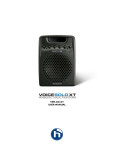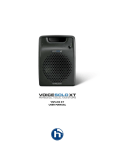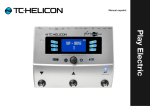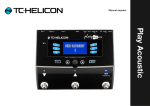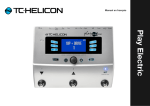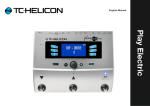Download Voice Solo XT VSM-200P XT User manual
Transcript
VSM-200P XT USER MANUAL IMPORTANT SAFETY INSTRUCTIONS The lightning flash with an arrowhead symbol within an equilateral triangle, is intended to alert the user to the presence of uninsulated “dangerous voltage” within the product’s enclosure that may be of sufficient magnitude to constitute a risk of electric shock to persons. The exclamation point within an equilateral triangle is intended to alert the user to the presence of important operating and maintenance (servicing) instructions in the literature accompanying the product. Read these instructions. Keep these instructions. Heed all warnings. Follow all instructions. Do not use this apparatus near water. Clean only with dry cloth. Do not block any ventilation openings. Install in accordance with the manufacturer's instructions. Do not install near any heat sources such as radiators, heat registers, stoves, or other apparatus (including amplifiers) that produce heat. Only use attachments/accessories specified by the manufacturer. Use only with the cart, stand, tripod, bracket, or table specified by the manufacturer, or sold with the apparatus. When a cart is used, use caution when moving the cart/apparatus combination to avoid injury from tip-over. Refer all servicing to qualified service personnel. Servicing is required when the apparatus has been damaged in any way, such as power-supply cord or plug is damaged, liquid has been spilled or objects have fallen into the apparatus, the apparatus has been exposed to rain or moisture, does not operate normally, or has been dropped. Warning! • To reduce the risk of fire or electrical shock, do not expose this equipment to dripping or splashing and ensure that no objects filled with liquids, such as vases, are placed on the equipment. Service • There are no user-serviceable parts inside. • All service must be performed by qualified personnel. 2 Table of Contents Introduction . . . . . . . . . . . . . . . . . . .5 Front panel diagram . . . . . . . . . . . . .7 Back panel diagram . . . . . . . . . . . . .8 Mic stand mounting procedure . . . .9 Using VoiceSoloXT . . . . . . . . . . . .13 Specifications . . . . . . . . . . . . . . . .15 Specifications, interface, and features are subject to change without notice due to continued product improvement VoiceSolo VSM-200P XT Rev 1.0 English version 3 4 Introduction Welcome to VoiceSoloXT The TC-Helicon VoiceSoloXT VSM range of near field live monitoring speakers is a new concept in personal monitoring. TC-Helicon strives for excellence in all things related to vocals, and the VSM range builds upon the success and worldwide reputation of TC-Helicon's vocal expertise. If you can't hear yourself correctly in a live situation, it's hard to produce a good performance. VSM monitors are designed to integrate into a boom-style microphone stand bringing the speaker close to the performer. This yields a wide range of benefits over existing wedge-type or in-ear options such as: • Lower monitor bleed into the main PA sound • High volume level before feedback • Better interaction with audience; stage space is reclaimed from floor wedges and ear plug barriers are not required as in in-ear monitors. The VoiceSoloXT VSM monitors use a two-way point source ICT ™ driver that eliminates the problem of hearing separated high and low frequencies which happens when listening to conventional speaker systems. This is especially important when used on a microphone stand as the speaker is located very close to the listener and the separation would be more evident. About TC-Helicon TC-Helicon’s core value is that the voice is the world's most beautiful instrument. Therefore, everything TCHelicon does is dedicated to this instrument. TC-Helicon envisions a world where those who work with voice are able to bring out its very best and where the possibilities of vocal craft are endless. The company's mission was galvanized by a simple question, "Isn't it time that someone finally provided dedicated tools and solutions for voice?" TC-Helicon is revolutionizing the vocal channel by providing innovative tools and solutions for people who create and work with the speaking and singing voice. Our customers include the most demanding of live performers, producers, broadcasters and recording engineers. Enjoy! VSM-200P XT Features: • Improved high frequency response in the critical 4 to 10 kHz range resulting in higher accuracy and smoother sound. • Quick mic stand set up. Integrates with boom so the same stand is used for the monitor and microphone. • Versatile placement options provided by dual stand mounting holes and dual bevelled edges for floor mounting. • Two-way point source 6.5" ICT™ driver for optimal nearfield live monitoring. • High power capacity: 240W peak • Cast aluminum enclosure for maximum rigidity and minimum cabinet resonance • Front panel mounted volume control for easy access. The TC-Helicon Team a TC Group company 5 Introduction Preliminary Recommendations The VoiceSoloXT VSM series of monitors are capable of very high sound pressure levels (SPLs) especially at the close range when integrated onto a microphone stand. They were designed this way to be able to be loud enough to compete with live acoustic drum kits. In situations where high monitoring volumes are required we recommend that ear protection be used. For continuous exposure we recommend the occasional use of a sound level meter capable of measuring the sound level over a period of exposure according to noise control standards. This should be used to check that noise levels are always within safety limits. Unpacking Open the box from the top and remove cabling. Lift out styrofoam insert, then using both hands lift out VoiceSoloXT. Remove plastic bag from VoiceSoloXT. Nothing in your speakers should rattle. Inspect each speaker for signs of transit damage. In the unlikely event of this having occurred inform the carrier and the supplier. Keep all the packaging if damage has occurred, as this will show evidence of excessive handling forces. It is also a good idea to keep the packaging if possible for future transportation. Registering VoiceSoloXT There are two methods for registering your VoiceSoloXT: • Online: visit www.tc-helicon.com/VoiceSolo and click Product Registration in the left hand column. • Mail: complete and return the registration card included with your product Support If you run into technical challenges, TC-Helicon will be more than happy to help. There are a number of sources for product support. We've prioritized them below according to the speed at which you will access the help information. 1. Manual: The manual for VoiceSoloXT VSM-200P is a good source of application information and answers for common questions. 3. On-Line: visit www.tcsupport.tc to search and ask for answers on up to date questions about VoiceSoloXT. 4. Phone: International: +45 8742 7000 USA & Canada: 818-665-4900 6 Front Panel Diagram 2 1 1. VOLUME level control This detented attenuator allows you to adjust your monitor level while staying close to your mic. This control functions differently than the volume control on an amplifier. As you turn up the volume on an amplifier, the amp works successively harder to produce more volume. With the VSM-200P XT volume control however, the amp continues to work hard whether your VoiceSoloXT’s volume control is turned up full or down. With a powerful amp and medium volume level expectations, this control can be used throughout its range. With less powerful amplifiers and high volume expectation, the most efficient path is to leave the VSM-200P XT volume control up full and for you to control volume with your mixer and/or amplifier. 2. Tuned bass port This allows VoiceSoloXT to produce low frequencies. It is also useful as a handle when carrying the unit. 7 Back Panel Diagram 1 2 1. Speakon® combo input jacks These jacks allow either a 1/4” speaker cable or Speakon equipped speaker cable to connect to VoiceSoloXT. These jacks are paralleled and can be used to chain several VSM-200P XT units together. Thus, both jacks are designated as IN/THRU. A note about chaining multiple VoiceSoloXTs Your VSM-200P XT has an impedance, or ohms rating, of 8 Ohms. Chaining two VSM-200P XTs together lowers the impedance the amp will have to drive to 4 Ohms. Most amps will work fine at 4 Ohms even when pushed to produce loud volume levels. Chaining three VSM-200P XTs will lower the impedance to 2.6 Ohms and adding a fourth VSM-200P XT will bring the impedance to 2 Ohms. Consult your amplifier’s manual to confirm that it is capable of driving a 2 Ohm load. Note that all Ohm ratings are specified with the volume control set to maximum. 8 2. Power handling legend This legend describes the amount of power your VSM200P XT will accept with various types of program material. 60W / AVERAGE: Also known as RMS, this means that VoiceSoloXT will accept audio of constant level e.g. a sine wave test signal of 60 watts for an extended period of time. 120W / PROGRAM: This rating describes how many watts VoiceSoloXT can accept over an extended period of time with dynamic program material such as what a band or singer would produce. 240W / PEAK: This is the maximum VoiceSoloXT can withstand for a very brief period of time. Mic Stand Mounting VoiceSoloXT Placement Options VoiceSoloXT can be placed in 4 different ways. This versatility allows you to use it as a mic stand mounted monitor one night, a PA system on another and then use it at home for practice or jamming. 1. Separate the boom from the stand by unscrewing the boom from the vertical shaft of the microphone stand. To do this, tighten the clutch you use to raise and lower the stand first. This makes it easier to unscrew the boom section. Hold the base of the stand with one hand and turn the boom counterclockwise (looking down from the top) with the other hand. Mic Stand Mounting Mic Stand Integration What you need: • VoiceSoloXT • Tripod microphone stand with boom - must be the style where the boom may be unscrewed from the vertical shaft of the microphone stand. • VoiceSoloXT adaptor hardware including: Mic Boom Mount Attachment 2. Screw the Mic Stand Mounting Insert on to the vertical shaft of the microphone stand. (If your stand has 3/8", European thread it will be necessary to use a 5/8" to 3/8" thread adapter, commonly included with both microphone stands and microphone clips) Mounting Insert Mic Stand Shaft Mic Stand Mounting insert * Tip: If you find that your VoiceSoloXT wobbles on the stand, try wrapping the Mic Stand Shaft threads with Teflon thread tape before screwing on the Mic Stand Mounting Insert. Teflon thread tape can be found at stores that sell plumbing supplies. 9 Mic Stand Mounting 3. Place VoiceSoloXT on the mic stand so the stand goes into the hole on the bottom of the VoiceSoloXT. If you don’t need to mount VoiceSoloXT on a boom stand, you are finished with your setup. If you require the boom, continue to the next step. 5. Screw the Mic Boom Mount Attachment into your boom. 6. Lift the lid on VoiceSoloXT, and while holding it open, slide the Mic Boom Mount attachment, on the boom into slot on top of the monitor and let the lid close. 4. The Mic Boom Mount is found in the bag of parts that came with your VoiceSoloXT. There are two versions: a thin one for European stands and a wider one for the rest. This adapter connects the boom of your mic stand with VoiceSoloXT. It is designed to fit into the top receptacle in VoiceSoloXT. 10 Mic Stand Mounting 7. Your VoiceSoloXT should now look like this. 2. Still holding the boom so that it does not swing away, turn the lock nut counter-clockwise until it’s snug against the bottom of the boom. Note that it’s not possible to completely tighten the lock nut with your fingers, the final action is done by swinging the boom snug against the lock nut. Adjusting the Boom To optimize line-of-sight and audibility it is usually better to have the monitor situated somewhat beside the singer. To do this it is necessary to adjust the position of the boom. The steps required to adjust the position of the boom are as follows: 1. With the VoiceSoloXT integrated into the mic stand and boom, loosen the boom by rotating to the right while holding onto a corner of VoiceSoloXT. 3. After tightening the lock nut with your fingers, swing the boom left, tightening to the desired position. It may be necessary to go through steps 1 - 3 a few times to get the boom tightly where you want it. The boom must be tight or the weight of the mic can cause it to swing out of position. Read the next section to learn how to connect your new VoiceSoloXT. 11 12 Using VoiceSoloXT Introduction The following paragraphs should be read at least once to learn more about safe and successful use of VoiceSoloXT. Making Connections Before connecting speaker cables First of all, turn the amplifier that will drive VoiceSoloXT off. This is a general rule when connecting any speaker to an amp. Plug in the speaker cable(s) Connect a proper speaker cable between your amplifier and VoiceSoloXT’s IN/THRU jacks. Note that speaker cables and input cables with 1/4” jacks look alike. Do not use input cables like the ones you would use to connect an instrument to an amp. Only use quality speaker cables available from your dealer. reduced sensitivity at the back-sides of the mic, there is more sensitivity directly at the back of the mic. • When using handheld mics near VoiceSoloXT never point the mic at the speaker. This seems obvious yet it happens all the time. • When VoiceSoloXT is fed by an amplified monitor send, ensure that the monitor send is Pre-EQ. This allows you to add EQ to the main PA sound on your channel but to send a flat (no EQ) signal to VoiceSoloXT. With a good mic and a strong singer, a flat monitor is likely to be louder than an EQ’d one. If you plan to chain multiple VSM-200P XTs onto a single amplifier channel, you may connect cables from either jack to the next speaker. Read the Back Panel Diagram note on page 8 regarding chaining VoiceSoloXTs. Turn down the amp If the amp has a volume control, it’s good practice to turn it to minimum before applying power. Also ensure that the device driving the amplifier has its volume turned off. Apply power to your amp After powering up, turn up the input control on the amp if it features this. Raising the level Adjust your mixer so that your mic or instrument is fed to a monitor send. Raise the send level slowly while you sing or say “check” into the mic until the level is sufficient. You’re now ready to perform with VoiceSoloXT! Overcoming feedback As in any open speaker and mic combination, there is the threat of feedback. For those who aren’t familiar with the term, “feedback” describes the sudden shriek or howl that happens when a mic hears the speaker’s sound and amplifies it. The following tips should help you to minimize the risk. • Always raise the volume level slowly, singing something into the mic as you do so. Feedback will give you a little warning if you listen carefully. When you hear a slight ringing while you check the mic, lower the level a little and this will become your “safe” monitoring level. • Consider your placement. When VoiceSoloXT is slightly off to one side as opposed to directly in front of you, you will hear it better and can hear well with less level. Side placement is also optimal when using mics with a hypercardioid pickup pattern because, in exchange for 13 14 Specifications Connectors 2 paralleled Speakon® combo jacks that accept Speakon or 1/4” connectors Speaker Speaker: 6.5 inch ICT custom-designed point source driver including inductively coupled tweeter Nominal impedance: 8 ohms 120 Watt Program / 240 Watt Peak power handling Sensitivity (I Watt @ 1 meter): 90 dB (1 kHz octave band) Conical dispersion: 90 degrees Frequency response: 120 Hz– 2 kHz Peak SPL: 116 dB @ .5 meter Case Enclosure of molded aluminum with integral bass port Color: Black Dimensions (H x W x D): 9” x 7” x 9.75” (23 cm x 18 cm x 25 cm) Shipping weight: 11 lbs. (5 kg) Net weight: 9.2 lbs. (4.2 kg) 15















